Abstract
The expansion, cracking and deterioration of properties during utilisation and solidification of municipal solid waste incineration bottom ash are key problems that are caused by the reaction of metallic aluminium in the bottom ash in the highly alkaline environment of hardened Portland cement. In this study, polyaluminium sulphate (PAS) was introduced into ordinary Portland cement (OPC) to inhibit the corrosion of aluminium alloy. The results indicate that PAS successfully inhibited the corrosion of Al in hardened OPC paste, prevented the expansion and cracking, reduced the amount of hydrogen gas release and formed a thinner and dense corrosion layer on the Al plate surface. The mechanism of corrosion inhibition of Al by PAS was the increase of initial Al(OH)4− concentration by hydrolysis, which expanded the pH range of passivation and transformed the porous loose bayerite layer to a dense homogeneous one around the Al plate without modification of the corrosion product (bayerite). The corrosion rate of the Al alloy in hardened OPC paste was reduced by 213 times by the addition of PAS, from 288.30 mm a−1 without PAS addition to 1.35 mm a−1 with PAS addition. This study casts light on the effective inhibition of corrosion of the Al alloy in OPC.
1. Introduction
Municipal solid waste incineration (MSWI) bottom ash could be utilised as building materials or solidified by cement as waste forms. One of the problems during this process is the reaction of metallic aluminium in the bottom ash in the highly alkaline environment of hardened Portland cement or geopolymer. This reaction will result in the formation of Al(OH)4−, Al(OH)3 and hydrogen gas [1,2], which causes expansion and cracking and deteriorates the durability of building materials or solidification bodies [3,4,5].
Some of the methods to solve this problem include removing or completely reacting the aluminium with an alkaline solution, such as recycling aluminium through metal recycling systems [6,7] or washing the bottom ash with alkaline solutions, such as sodium hydroxide, sodium carbonate or sodium bicarbonate [5,8,9]. For the recycling of aluminium through metal recycling systems, the size separation is first performed by screens or drums to select the more aluminium-containing fraction. Then, the eddy current separator is used to select the aluminium alloy. Approximately 30–70% of aluminium in the bottom ash could be recycled by eddy current separators. Recycling aluminium through metal recycling systems requires investment in equipment, and only the monolithic aluminium alloys can be recycled. Small aluminium alloy particles could not be effectively recycled by this method. Washing the bottom ash with an alkaline solution to complete the reaction between aluminium alloy and the alkaline solution will take days or weeks. This method also results in the production of new liquid waste. These alkaline liquid wastes are difficult to treat.
The other methods aim to avoid the corrosion of aluminium through electrolytic oxidation or anodic oxidation [10,11,12,13]. For MSWI bottom ash with relatively low aluminium content, electrolytic oxidation is usually used. For MSWI bottom ash with relatively high aluminium content, anodic oxidation is used to form a thin and porous oxide film on the surface of the Al alloy [14,15,16]. Usually, further treatments are performed to reduce the porosity of this porous oxide film by using sealing materials to seal the pores on the surface of the oxide film [16,17,18,19,20,21,22,23]. So, anodic oxidation is complex, time-consuming and increases the cost.
All these methods require the pretreatment of bottom ash, which increases the cost of utilisation and solidification.
A previous study on the reaction of aluminium powder with ordinary Portland cement (OPC) or calcium aluminate cement-based (CAC) systems reported that 6 wt% of aluminium powder reacted with OPC paste, while 2.3 wt% of aluminium powder reacted with the CAC-based system [24]. A relationship between the reaction amount of aluminium powder and the amount of calcium hydroxide in the paste was proposed. This is due to the lower pH in the CAC-based system. However, the reaction of aluminium with the CAC-based system continued for up to 28 days, which is the maximum time reported. That is because the pH in a CAC-based system is still high. There are other studies on the various cement system [25,26,27,28] that tried to reduce the pH of the cement pore solution to prevent the corrosion of aluminium. However, it is hard to reduce the pH further because that will hinder the reaction of cement, especially during the early-age hydration of cement.
The Pourbaix diagram of the Al/H2O system [29] shows the relationship between the potential and pH during the corrosion of aluminium. When the equilibrium activity of Al is 10−6 mol L−1 and the pH of the solution is between 4.44 and 10.53, the aluminium is passivated with the corrosion product of bayerite (Al(OH)3) and the pH range of passivation is controlled by the Al ion activity. For a low-concentration solution, the activity of ions is almost the same as the concentration. By increasing the Al(OH)4− concentration of the solution, the pH range of aluminium passivation could increase from 10.53 to a higher pH.
The dissolution of aluminate salts, such as NaAlO2, may increase the Al(OH)4− concentration in the solution. However, these salts will increase the pH of the solution as well. It would be ideal to use a salt to provide Al(OH)4− without increasing the pH value of the solution during dissolution. Polyaluminium sulphate (PAS) is an inorganic coagulant salt consisting of aluminium and sulphate. When PAS is mixed with water, it releases Al(OH)4− and poly-Al-oxyhydroxide into the solution during the hydrolysis of PAS, and slightly decreases the pH value of the solution [30,31,32]. When added to the Portland cement, it is possible to increase the Al(OH)4− concentration and expand the pH range of passivation of the Al alloy so as to inhibit the corrosion of Al in bottom ash.
In this study, PAS was introduced into ordinary Portland cement (OPC) to investigate the inhibition effect of PAS on the aluminium corrosion in the highly alkaline environment of hardened OPC paste. The mineral assemblage, microstructure and chemical composition of corrosion products were characterised by a range of analytical techniques, and the corrosion inhibition mechanism of aluminium by PAS was discussed. The aim of this study is to propose a simple method to passivate the aluminium in highly alkaline OPC paste to prevent the expansion and deterioration of hardened OPC paste.
2. Materials and Methods
2.1. Materials
Ordinary Portland cement (OPC, type P.O 52.5) was purchased from Huaxin Cement Co., Ltd. (Wuhan, China). Polyaluminium sulphate (PAS) was purchased from Yongshun Purification Materials Trading Co., Ltd. (Gongyi, China). Aluminium alloy of type 1060 was used in this study with a purity of 99.6%. The sizes of Al plates used in this study were 1 × 18 × 18 mm3 for evaluation of appearance of hardened OPC pastes embedding Al plates, 60 × 1 × 2 mm3 for the tests of corrosion of Al plates in hardened OPC pastes, 5 × 1 × 15 mm3 for the tests of Al plates’ corrosion in simulated pore solution, and 10 × 1 × 15 mm3 for the tests of Al plates’ corrosion in a simulated pore solution by polarisation curves.
The polycarboxylate superplasticiser (SP, type 929) was purchased from FuClear Technology Co., Ltd. (Suzhou, China). Sodium metasilicate (Na2SiO3·9H2O, Analytical Reagent (AR) grade) was purchased from Aladdin (Shanghai, China). Calcium hydroxide (Ca(OH)2, AR grade), potassium hydroxide (KOH, AR grade), sodium aluminate (NaAlO2, CR grade), sodium sulphate (Na2SO4, AR grade) and sodium hydroxide (NaOH, AR grade) were purchased from Sinopharm (Shanghai, China). The chemical composition and mineral assemblage of OPC and PAS were identified by X-ray Fluorescence Spectrometry (XRF) and X-ray diffraction (XRD) and shown in Table 1 and Figure 1, respectively.

Table 1.
Chemical composition of OPC and PAS (wt%).
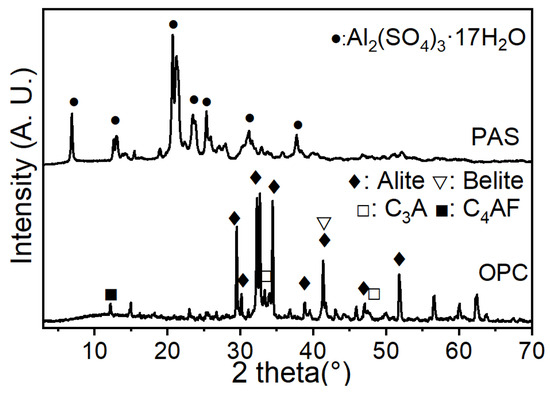
Figure 1.
XRD patterns of raw materials (OPC and PAS).
2.2. Sample Preparation
The mix design of OPC pastes with or without PAS is listed in Table 2, where PAS, SP and water were added as a weight percentage of OPC. The water-to-cement ratio (w/c) was kept at 0.35. Raw materials powder was first mixed for 1–2 min to obtain homogeneous mixing before the water was added, and then the paste was mixed at low speed for 10 min before being mixed at high speed for another 2 min.

Table 2.
Mix design of OPC pastes with PAS addition (wt% †).
2.2.1. Sample Preparation for the Appearance of Hardened OPC Pastes Embedding Al Plates
For the evaluation of the appearance of hardened OPC pastes embedding Al plates, the above-mentioned fresh pastes were poured in the moulds in sizes of 50 mm in diameter and 50 mm in height, and a piece of Al plate sized 1 × 18 × 18 mm3 was placed in the top-middle of the sample. The sample was then sealed by plastic wrap and cured at room temperature. The samples were demoulded at 1 day of hydration and placed in sealed plastic bags for curing at room temperature before tests.
For the corrosion rate test of Al plates embedded in OPC pastes, OPC pastes were poured in plastic tubes of 15 mL, and Al plates sized 1 × 60 × 2 mm3 were inserted in the middle of the paste (Figure 2). Then, the plastic tubes were sealed, and the pastes were cured at room temperature for 3 and 28 days. The hardened OPC pastes were removed from the plastic tubes and cut into slices. The slices were then observed with a scanning electron microscope (SEM) and the element distribution was evaluated by an energy-dispersive X-ray spectroscope (EDX). The Al plates were also removed from the hardened paste and then transferred to XRD for mineral assemblage analysis.

Figure 2.
Schematic diagram of sample preparation for the corrosion of Al plates in hardened OPC pastes.
2.2.2. Sample Preparation for Al Plates’ Immersion in Simulated Pore Solutions
The pore solution of OPC paste (PC-P0) at 3 days of hydration was obtained by extrusion from hardened paste in a stainless steel die. Then the pH and ion concentrations of the pore solution were characterised for preparation of simulated pore solution of PC-P0 at 3 days according to Table 3. The simulated pore solutions of OPC pastes with PAS addition were prepared according to Table 4.

Table 3.
Chemicals used to prepare the simulated pore solution of PC-P0 sample at 3 days of hydration.

Table 4.
Preparation of simulated pore solution (g).
For the analysis of the mechanism of corrosion inhibition of PAS on the Al plates in OPC pastes, Al plates sized 1 × 15 × 5 mm3 were immersed in the simulated pore solution listed in Table 4 in sealed bottles, as illustrated in Figure 3. The pH and aluminium ion concentrations of the simulated pore solution were measured up to 16 h. Then the Al plates were removed from the simulated pore solutions, and the surfaces were observed under SEM with the element distribution characterised by EDX. The mineral assemblage of corrosion products on the surface of Al plates was characterised by XRD.
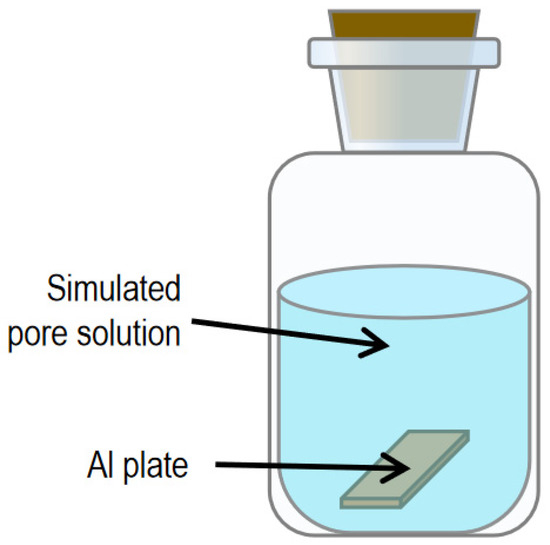
Figure 3.
Schematic diagram of sample preparation for Al plates’ immersion in the simulated pore solution of hardened OPC pastes with various amounts of PAS addition.
The corrosion rates of Al plates in simulated pore solutions were evaluated by polarisation curves.
2.3. Test Methods
2.3.1. Microstructure and Chemical Composition
An environmental scanning electron microscope (ESEM, Quanta FEG 450, Thermo Fisher Scientific Inc., Waltham, MA, USA) was used to characterise the microstructure of the corrosion of Al plates in hardened OPC pastes under the backscattered electron mode (BSE) with an acceleration voltage of 20 kV. The microstructures of Al plates immersed in simulated pore solution up to 16 h were observed by the same ESEM under the secondary electron mode (SE). The element distribution of both samples was characterised by an AZtecLiveOne Xplore 15 EDX detector (Oxford Instruments, Abington, UK).
2.3.2. Phase Assemblage on the Surface of Al Plates
The phase assemblages on the surface of Al plates in hardened OPC pastes and in the simulated pore solutions were characterised by XRD (Bruker D8 Advance, Billerica, MA, USA).
2.3.3. Polarisation Curve Analysis and Corrosion Rate of Al Plates in Simulated Pore Solution
To evaluate the corrosion rate of Al plates in the simulated pore solution, Al plates were immersed in the simulated pore solutions, and the polarisation curves were recorded. Electrochemical workstation (Wuhan Koster Instrument Co., Ltd., Wuhan, China) was employed to perform the polarisation curve analysis. Calomel electrode immersed in saturated KCl solution was used as reference, platinum plate as counter electrode and Al plate as working electrode. The test was performed under the condition of a scanning rate of 10−3 V s−1 with a potential range of −0.15–0.35 V. The corrosion rate of Al plates in various simulated pore solutions was calculated by the Tafel method.
3. Results and Discussions
3.1. Appearance of Hardened OPC Paste Embedding Al Plate
After 3 days of hydration, the top of the cylinder sample of PC-P0 with an Al plate expanded and cracked around the Al plate (Figure 4a,b). This is because of the corrosion of the Al plate in the alkaline environment of the cement pore solution. A previous study found that the extensive spalling on the surface of concrete made with MSWI bottom ash artificial aggregates was mainly caused by the expansive reaction of aluminium with concrete [33]. These findings are similar to the appearance of the PC-P0 sample. For the PC-P3 sample with the Al plate inserted (Figure 4c,d), the appearance of the top of the cylinder sample was similar to that of PC-P0, indicating that the corrosion degree was similar and the addition of 3 wt% PAS did not effectively prevent the corrosion of the Al plate by the pore solution of the OPC paste. For the PC-P6 sample with the Al plate inserted (Figure 4e,f), the top of the sample was flat, and no expansion or crack was observed, indicating that the corrosion of the Al plate was successfully inhibited by the addition of PAS.


Figure 4.
Appearance of the top of the samples of OPC pastes with Al plates at 3 days of hydration: (a,b): PC-P0; (c,d): PC-P3; and (e,f): PC-P6 samples.
3.2. Corrosion of Al Plates in Hardened OPC Paste
The microstructures of Al plates in OPC pastes with or without PAS addition at 3 and 28 days of hydration were characterised by SEM under the BSE mode and shown in Figure 5 and Figure 6. According to Figure 5, at 3 days of hydration of OPC pastes, the Al plate in OPC paste without PAS addition (PC-P0) was severely corroded, resulting in the release of hydrogen gas and the formation of large pores around the Al plate (Figure 5a,b). According to the literature [1,2], when the pH of the solution is higher than 11.75, aluminium will react with the solution to release H2 gas and form Al(OH)4− and Al(OH)3. In this study, the reaction between the Al plate and the OPC pore solution was so strong that the hydrogen gas separated the Al plate from the hardened OPC paste. There was a thick loose layer of corrosion products with a width of 100–200 μm observed around the surface of the Al plate.

Figure 5.
SEM BSE images of Al plates in hardened OPC pastes with various amounts of PAS hydrated at 3 days: (a) and (b): PC-P0; (c) and (d): PC-P3; and (e–g): PC-P6 samples.

Figure 6.
SEM BSE images of Al plates in hardened OPC pastes with various amounts of PAS hydrated at 28 days: (a–c): PC-P0; (d) and (e): PC-P3; and (f–h): PC-P6 samples.
For the Al plate in OPC paste with 3 wt% PAS addition (PC-P3) at 3 days of hydration (Figure 5 c,d), the releasing of a large amount of hydrogen gas around the Al plate was observed as well, resulting in the big pore surrounding the Al plate. The size of the pore was relatively smaller than that in the PC-P0 paste. There was a loose layer of corrosion products with a width of 40–200 μm around the Al plate. These results indicate that the reaction between the Al plate and OPC paste is still strong, with 3 wt% PAS addition. The thickness of the corrosion layer (Figure 5d) was reduced compared to that in the PC-P0 paste (Figure 5b).
For the Al plate in OPC paste with 6 wt% PAS addition (PC-P6) at 3 days of hydration (Figure 5e,f), there was no big pore observed around the Al plate. Some small pores sized 200 μm were observed in the matrix of hardened OPC paste. There was a thin, tight layer of corrosion products with a width of 20 μm formed around the Al plate. The interface between the OPC paste and the corrosion products was well connected. The crack in the corrosion products in Figure 5f was due to the loss of water during the sample preparation. According to these results, at 3 days of hydration of OPC paste, the addition of 6 wt% of PAS in OPC paste successfully inhibited the corrosion of the Al plate, preventing the release of a large amount of hydrogen gas. A thinner and tighter layer of corrosion products on the surface of the Al plate was formed.
After 28 days of hydration of OPC pastes, for the Al plate in PC-P0 (Figure 6a–c), there was still a large amount of pores observed around the Al plate and a thick, loose layer of corrosion products was formed on the surface of the Al plate. Porous layers of corrosion products with a width of 100–200 μm with a large amount of pores inside were observed (Figure 6c). These results indicate that the corrosion was still intense after 28 days of hydration for the Al plate in the OPC paste without PAS addition. The pH of hardened OPC paste is usually higher than 13, which is a supersaturated solution of calcium hydroxide with other ions [33]. This highly alkaline pore solution will continuously react with the Al plate, resulting in the formation of more corrosion products and hydrogen gas.
For OPC paste with 3 wt% PAS addition (PC-P3), a large amount of big pores was observed around the Al plate and in the matrix of OPC paste (Figure 6d,e). The corrosion degree of the Al plate was similar to that in PC-P0 at the same age and the corrosion was more severe than that in the same paste at 3 days of hydration. These results indicate that the Al plate was continuously corroded during the hydration of the OPC paste. The microstructure of the thick, loose corrosion layer was similar to that in PC-P0, with a thickness of 100–200 μm.
For the OPC paste with 6 wt% PAS addition (PC-P6) in Figure 6f–h, the microstructure was similar to that of the same paste at 3 days of hydration. A slightly thicker layer of corrosion products with a width of 20–30 μm was formed. There were still some small pores in the matrix of the OPC paste that formed during early-age hydration. The interface between the corrosion layer and the OPC matrix was compact. The corrosion layer was tight. These results indicate that 6 wt% PAS inhibited the strong Al plate corrosion induced by the pore solution of the OPC paste. The reason for the formation of a thinner and denser layer of corrosion products could be due to the higher Al(OH)4− concentration in the initial stage of corrosion by the hydrolysis of PAS [30]. The higher Al(OH)4− concentration prevented the dissolution of the corrosion product (Al(OH)3) to soluble Al(OH)4− according to the Pourbaix diagram [29].
The element distribution map of the PC-P6 sample with the Al plate was obtained by EDX and is shown in Figure 7. According to these element distribution maps, the corrosion products contained aluminium and oxygen. There was no aluminium diffused into the matrix of OPC paste to form a new product, and there was no calcium or silicon diffused into the corrosion product layer either. It seems that the type of corrosion product was not altered by the hydration of OPC. The hydration of OPC paste was not affected by the corrosion of the Al plate either.
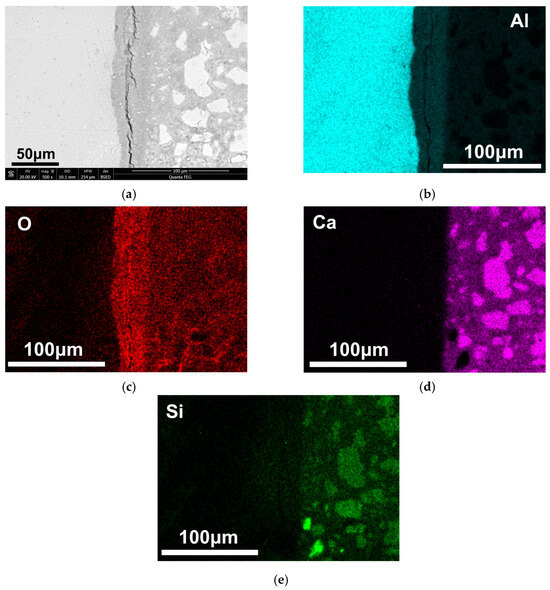
Figure 7.
Element distribution maps of PC-P6 around the corrosion layer at 28 days of hydration of the OPC paste: (a) BSE image; (b) Al; (c) O; (d) Ca; and (e) Si element distribution maps.
The mineral phases on the surface of the Al plate in the PC-P0 and PC-P6 samples at 3 days of hydration were identified by XRD (Figure 8). According to these XRD patterns, the corrosion product on both Al plates was bayerite (Al(OH)3). A small amount of one of the hydration products of OPC paste, ettringite, was also identified on the surface of the corrosion layer. This inclusion of ettringite was due to the incomplete separation of corrosion products from the OPC paste matrix.
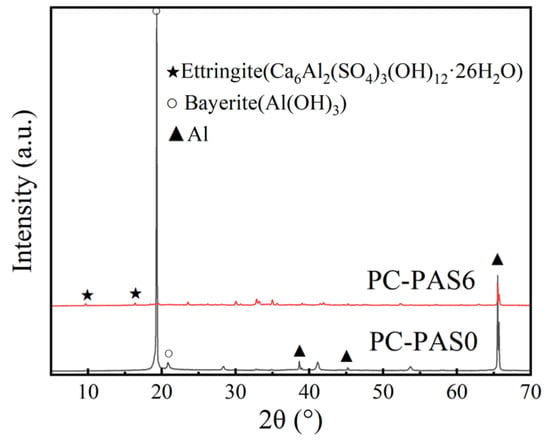
Figure 8.
XRD patterns of corrosion products on the surface of Al plates in the PC-P0 and PC-P6 samples at 3 days of hydration.
3.3. Mechanism of Corrosion Inhibition of Al Alloy in OPC Paste by PAS
To clarify the corrosion inhibition mechanism of Al plates in OPC pastes by PAS, Al plates were immersed in the simulated pore solutions. The changes in pH and aluminium ion concentration of the simulated pore solution in the first 16 h are shown in Figure 9. The initial pH of PP2 was slightly lower than that of PP0 (Figure 9a) because of the hydrolysis of PAS, which reduced pH [32]. Both the pH of PP0 and PP2 decreased with the increase of immersion time of Al plates in the simulated pore solution due to the reaction of the Al plate with the simulated pore solution. This reaction resulted in the formation of bayerite and Al(OH)4−, and the release of hydrogen gas. The pH value of PP2 was always lower than that of PP0, and the difference in pH value increased with the time of immersion, especially after 8 h of immersion of the Al plates. By 12 h, the pH of PP2 was approximately 0.1 lower than that of PP0, and both pH values were stable by 16 h. A lower pH value is beneficial for the corrosion inhibition of the Al plate.
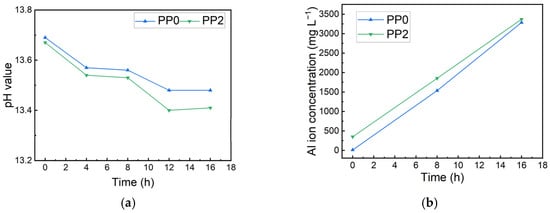
Figure 9.
Change of (a) pH and (b) Al ion concentration in PP0 and PP2 in the first 16 h of immersion.
For the change of Al ion concentration (Figure 9b), the initial Al ion concentration of PP2 was higher than that of PP0 due to the hydrolysis of PAS, which released Al(OH)4− ion into the simulated pore solution. The Al ion concentration of both PP0 and PP2 increased with the time of immersion of the Al plate, indicating that Al plates reacted with the simulated pore solution. This reaction resulted in the release of Al(OH)4− into the solution from Al plates. By 16 h of immersion, the Al ion concentrations in both PP0 and PP2 were similar.
These results indicate that the change of pH by the addition of PAS cannot explain the corrosion inhibition of Al plates in the OPC paste because the pH of the pore solution after the addition of PAS is still much higher than 11.75, which could not prevent the Al corrosion. The higher Al(OH)4− concentration at the initial stage in PP2 could be the reason for the inhibition. According to the Pourbaix diagram of Al corrosion [29], the higher Al(OH)4− concentration could expand the pH range of passivation.
The microstructure and elemental mapping of Al plates immersed in PP0 and PP2 simulated pore solution were characterised by SEM-EDX and are shown in Figure 10. There were layers of corrosion products on the surface of Al plates in both PP0 and PP2 simulated pore solutions. A porous corrosion layer with pores sized approximately 40 μm was observed on the surface of the Al plate in PP0 (Figure 10a–e). These big pores will favour the transportation of the alkaline solution to the surface of the Al plate, resulting in continuous corrosion. The corrosion layer of the Al plate in PP2 showed fewer pores with a dense structure (Figure 10f–j), which could inhibit further corrosion once the corrosion layer formed. The dense corrosion layer will prevent the transportation of the simulated pore solution to the surface of the Al plate.


Figure 10.
Microstructure and elemental mapping of Al plates in (a–e) PP0 and (f–j) PP2 for 16 h.
According to the elemental mapping of both Al plates in PP0 and PP2, the chemical compositions of corrosion products were similar, but the elemental mappings for PP2 were more homogeneous compared to those in PP0. There was some uneven distribution of sodium for the Al plate in PP0. These results elucidate that the corrosion inhibition effect could be due to the formation of a dense layer of corrosion products on the surface of the Al plate, rather than the alternation of corrosion products. Point analysis of the chemical composition of corrosion products on the surface of the Al plate in PP2 further confirmed the formation of bayerite (Figure 11 and Table 5). The mineral phases on the surface of Al plates immersed in PP0 and PP2 for 16 h were identified by XRD and are shown in Figure 12. These XRD patterns also confirmed that the corrosion products in both situations were bayerite.
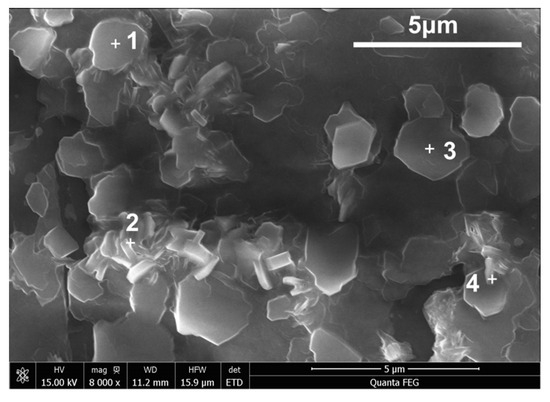
Figure 11.
Morphology of corrosion products and position of point analysis (position 1–4) of the chemical composition of the Al plate in PP2 for 16 h.

Table 5.
Chemical composition of points in Figure 11 (at%).
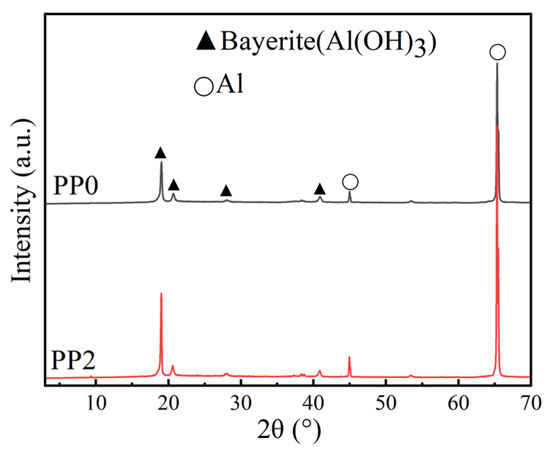
Figure 12.
XRD patterns of corrosion products on the surface of Al plate immersed in PP0 and PP2 for 16 h.
According to the results of Al ion concentrations of simulated pore solutions and the microstructure of the corrosion layers, the mechanism of corrosion inhibition of the Al plate by PAS could be the initial Al(OH)4− concentration increase by PAS hydrolysis. The higher Al(OH)4− concentration induced the expansion of the pH range of passivation and prevented the dissolution of bayerite to Al(OH)4−, resulting in the densification of the corrosion layer. This dense corrosion layer prevented further corrosion of the Al plate in the hardened OPC paste.
3.4. Corrosion Rate of Al Alloy in OPC Paste
The polarisation curves and the calculated corrosion rate of Al plates in both PP0 and PP2 were measured and calculated, as shown in Figure 13. According to the polarisation curves of Al plates in PP0 and PP2 (Figure 13a), the shape and tendency of both polarisation curves were similar. These results show that the addition of PAS did not alter the corrosion mechanism of the Al plate in the simulated pore solution of OPC paste, although the corrosion potential was changed by the addition of PAS.
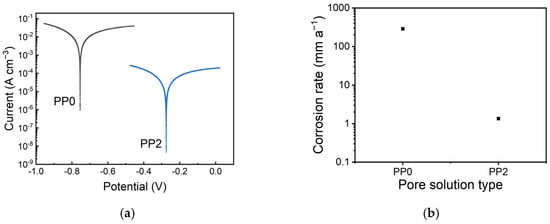
Figure 13.
(a) Polarisation curves and (b) corrosion rate of Al plate in PP0 and PP2.
The corrosion rates (Figure 13b) of the Al plate in PP0 and PP2 were calculated according to the Tafel method. The corrosion rate in PP0 was 288.30 mm a−1, and that in PP2 was 1.35 mm a−1, indicating that the corrosion rate of the Al plate was 213 times slower with the addition of PAS than that in the OPC paste. These results show that the addition of PAS in OPC paste could greatly inhibit the corrosion of Al alloy in the hardened OPC paste.
3.5. Mechanism of Corrosion Inhibition of PAS on the Al Alloy in OPC Paste
According to the results obtained and the discussions, the inhibition of Al alloy corrosion in OPC paste by the addition of PAS could be illustrated in Figure 14. For the Al plate in OPC paste without the addition of PAS, the high pH of the pore solution of the OPC paste induced the corrosion of the oxide layer and metallic aluminium. Hydrogen gas was released and Al(OH)4− was released into the pore solution. A thick, porous layer of bayerite was formed on the surface of the Al plate, favouring the continuous corrosion of Al alloy. The release of hydrogen gas and formation of a porous bayerite layer resulted in the expansion and cracking of the OPC paste.
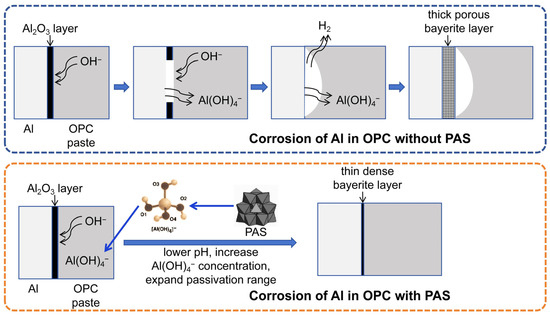
Figure 14.
Schematic diagram of the corrosion inhibition effect of PAS on the Al plate in hardened OPC paste.
For the Al plate in OPC paste with the PAS addition, the hydrolysis of PAS released a large amount of Al(OH)4− into the pore solution during the mixing of fresh paste. The pH was lowered as well. The increase of Al(OH)4− concentration expanded the passivation range of pH for the Al plate in the high-pH environment. The synergistic effect of lowered pH and increased Al(OH)4− concentration resulted in the formation of a thin, dense layer of bayerite on the surface of the Al plate, which prevented further corrosion of Al in the hardened OPC paste.
4. Conclusions
The corrosion inhibition effect of PAS on the Al alloy in the hardened OPC paste was investigated by a range of analytical techniques. According to the results obtained, the following conclusions can be drawn.
The corrosion of Al in OPC paste was successfully inhibited by the addition of 6 wt% PAS, which prevented the expansion and cracking of hardened OPC paste, resulting in much less hydrogen gas release and a thinner and dense corrosion layer around the Al plate.
The addition of PAS in OPC paste slightly reduced the pH value of the solution, increased the initial Al(OH)4− concentration, which broadened the passivation regime of pH, and transformed the porous loose corrosion layer into a dense homogeneous one without altering the corrosion product, bayerite. No aluminium was diffused into the hydration products of the OPC paste and the type of hydration product was not modified either.
The corrosion rate of the Al plate in the OPC paste was reduced by 213 times by the addition of PAS, from 288.30 mm a−1 without PAS addition to 1.35 mm a−1 with PAS addition.
This study casts light on the effective inhibition of corrosion of the Al alloy during the application of Al moulds in construction sites and the immobilisation of Al-containing solid waste by OPC.
Author Contributions
Conceptualization, H.G. and Q.L.; methodology, H.G.; software, H.M.; validation, H.G. and H.M.; formal analysis, H.G. and Q.W.; investigation, H.G. and Q.W.; resources, Q.L.; data curation, H.G. and Q.W.; writing—original draft preparation, H.G.; writing—review and editing, H.M. and Q.L.; visualization, H.G.; supervision, Q.L.; project administration, H.G. and Q.L.; funding acquisition, Q.L. All authors have read and agreed to the published version of the manuscript.
Funding
This research received no external funding.
Informed Consent Statement
Not applicable.
Data Availability Statement
The original contributions presented in this study are included in the article. Further inquiries can be directed to the corresponding author.
Conflicts of Interest
Author Qi Wei was employed by the company Wuhan Xinxin Semiconductor Manufacturing Co., Ltd. The remaining authors declare that the research was conducted in the absence of any commercial or financial relationships that could be construed as a potential conflict of interest.
References
- Adhikari, S.; Hebert, K.R. Participation of Aluminum Hydride in the Anodic Dissolution of Aluminum in Alkaline Solutions. J. Electrochem. Soc. 2008, 155, C189. [Google Scholar] [CrossRef]
- Mercier, D.; Barthés-Labrousse, M.G. The role of chelating agents on the corrosion mechanisms of aluminium in alkaline aqueous solutions. Corros. Sci. 2009, 51, 339–348. [Google Scholar] [CrossRef]
- Muller, U.; Rubner, K. The microstructure of concrete made with municipal waste incinerator bottom ash as an aggregate component. Cem. Concr. Res. 2006, 36, 1434–1443. [Google Scholar] [CrossRef]
- Bertolini, L.; Carsana, M.; Cassago, D.; Quadrio Curzio, A.; Collepardi, M. MSWI ashes as mineral additions in concrete. Cem. Concr. Res. 2004, 34, 1899–1906. [Google Scholar] [CrossRef]
- Xuan, D.; Tang, P.; Poon, C.S. Limitations and quality upgrading techniques for utilization of MSW incineration bottom ash in engineering applications—A review. Constr. Build. Mater. 2018, 190, 1091–1102. [Google Scholar] [CrossRef]
- Grosso, M.; Biganzoli, L.; Rigamonti, L. A quantitative estimate of potential aluminium recovery from incineration bottom ashes. Resour. Conserv. Recycl. 2011, 55, 1178–1184. [Google Scholar] [CrossRef]
- Biganzoli, L.; Grosso, M. Aluminium recovery from waste incineration bottom ash, andits oxidation level. Waste Manag. Res. 2013, 31, 954–959. [Google Scholar] [CrossRef]
- Mary Joseph, A.; Snellings, R.; Nielsen, P.; Matthys, S.; De Belie, N. Pre-treatment and utilisation of municipal solid waste incineration bottom ashes towards a circular economy. Constr. Build. Mater. 2020, 260, 120485. [Google Scholar] [CrossRef]
- Xuan, D.; Poon, C.S. Removal of metallic Al and Al/Zn alloys in MSWI bottom ash by alkaline treatment. J. Hazard. Mater. 2018, 344, 73–80. [Google Scholar] [CrossRef]
- Pezzato, L.; Coelho, L.B.; Bertolini, R.; Settimi, A.G.; Brunelli, K.; Olivier, M.; Dabala, M. Corrosion and mechanical properties of plasma electrolytic oxidation-coated AZ80 magnesium alloy. Mater. Corros. 2019, 70, 2103–2112. [Google Scholar] [CrossRef]
- Yu, X.W.; Li, G.Q. XPS study of cerium conversion coating on the anodized 2024 aluminum alloy. J. Alloys Compd. 2004, 364, 193–198. [Google Scholar] [CrossRef]
- Chen, J.H.; He, Z.; Liu, J.M.; Wang, Y.X.; Hodgson, M.; Gao, W. Antibacterial anodic aluminium oxide-copper coatings on aluminium alloys: Preparation and long-term antibacterial performance. Chem. Eng. J. 2023, 461, 141873. [Google Scholar] [CrossRef]
- Usman, B.J.; Scenini, F.; Curioni, M. The effect of exposure conditions on performance evaluation of post-treated anodic oxides on an aerospace aluminium alloy: Comparison between salt spray and immersion testing. Surf. Coat. Technol. 2020, 399, 126157. [Google Scholar] [CrossRef]
- Rashid, K.H.; Khadom, A.A. Sulfosalicylic/oxalic acid anodizing process of 5854 aluminum-magnesium alloy: Influence of sealing time and corrosion tendency. Results Chem. 2022, 4, 100289. [Google Scholar] [CrossRef]
- Machado, C.d.S.C.; Klumpp, R.E.; Ayusso, V.H.; Donatus, U.; Milagre, M.X.; Araujo, J.V.d.S.; Machado, G.A.F.; Costa, I. Effect of surface treatments on the localized corrosion resistance of the AA2198-T8 aluminum lithium alloy welded by FSW process. Surf. Interface Anal. 2019, 51, 1231–1239. [Google Scholar] [CrossRef]
- Gad, S.M.; Jin, Z.; Emad, S.; Vergara, J.E.; Yawas, D.S.; Dagwa, I.M.; Momoh-Bello Omiogbemi, I. Potential of rare-earth compounds as anticorrosion pigment for protection of aerospace AA2198-T851 alloy. Heliyon 2023, 9, e14693. [Google Scholar] [CrossRef]
- Shahzad, M.; Chaussumier, M.; Chieragatti, R.; Mabru, C.; Rezai-Aria, F. Effect of sealed anodic film on fatigue performance of 2214-T6 aluminum alloy. Surf. Coat. Technol. 2012, 206, 2733–2739. [Google Scholar] [CrossRef]
- Hu, N.; Dong, X.; He, X.; Browning, J.F.; Schaefer, D.W. Effect of sealing on the morphology of anodized aluminum oxide. Corros. Sci. 2015, 97, 17–24. [Google Scholar] [CrossRef]
- Lee, J.; Kim, Y.; Jang, H.; Chung, W. Cr2O3 sealing of anodized aluminum alloy by heat treatment. Surf. Coat. Technol. 2014, 243, 34–38. [Google Scholar] [CrossRef]
- Kuznetsov, B.; Serdechnova, M.; Tedim, J.; Starykevich, M.; Kallip, S.; Oliveira, M.P.; Hack, T.; Nixon, S.; Ferreira, M.G.S.; Zheludkevich, M.L. Sealing of tartaric sulfuric (TSA) anodized AA2024 with nanostructured LDH layers. RSC Adv. 2016, 6, 13942–13952. [Google Scholar] [CrossRef]
- Liu, J.; Shi, H.; Yu, M.; Du, R.; Rong, G.; Li, S. Effect of divalent metal ions on durability and anticorrosion performance of layered double hydroxides on anodized 2A12 aluminum alloy. Surf. Coat. Technol. 2019, 373, 56–64. [Google Scholar] [CrossRef]
- Fang, X.; Zeng, Y.; Mu, S.; Du, J.; Guo, J.; Li, W.; Fan, Y. Study on the effect of acetate ions on the sealing treatment for anodic oxide film of 6063 aluminum alloy. Surf. Coat. Technol. 2023, 472, 129961. [Google Scholar] [CrossRef]
- Zhang, S.; Wang, C.; Zhao, S.; Niu, A.; Ma, Y.; Liu, B. Enhanced long-term corrosion protection of 2A14 aluminum alloy: Hybrid effect of micro-arc oxidation coating and cerium based conversion treatment. Surf. Coat. Technol. 2023, 464, 129579. [Google Scholar] [CrossRef]
- Kinoshita, H.; Swift, P.; Utton, C.; Carro-Mateo, B.; Marchand, G.; Collier, N.; Milestone, N. Corrosion of aluminium metal in OPC- and CAC-based cement matrices. Cem. Concr. Res. 2013, 50, 11–18. [Google Scholar] [CrossRef]
- Bulidon, N.; Pelissier, K.; Boissy, C.; Mendibide, C.; Maillot, V.; Bourbon, X.; Crusset, D. Hydrogen production through aluminium corrosion in a cement-based matrix. Mater. Corros. 2023, 74, 1765–1776. [Google Scholar] [CrossRef]
- Delpech, S.; Cannes, C.; Barré, N.; Tran, Q.T.; Sanchez, C.; Lahalle, H.; Lambertin, D.; Gauffinet, S.; Coumes, C.C.D. Kinetic Model of Aluminum Behavior in Cement-Based Matrices Analyzed by Impedance Spectroscopy. J. Electrochem. Soc. 2017, 164, C717–C727. [Google Scholar] [CrossRef]
- Liu, S.H.; Chang, S.; Tu, Y.J.; Luo, S.Q. Immobilisation mechanism for nuclear waste containing aluminium by supersulfated cement containing phosphogypsum. Cem. Concr. Compos. 2023, 139, 104991. [Google Scholar] [CrossRef]
- Setiadi, A.; Milestone, N.B.; Hill, J.; Hayes, M. Corrosion of aluminium and magnesium in BFS composite cements. Adv. Appl. Ceram. 2006, 105, 191–196. [Google Scholar] [CrossRef]
- Ghali, E. Fundamentals of Electrochemical Corrosion. In Corrosion Resistance of Aluminum and Magnesium Alloys; Revie, R.W., Ghali, E., Eds.; John Wiley & Sons, Inc.: Hoboken, NJ, USA, 2010; pp. 1–48. [Google Scholar]
- Chen, Z.Y.; Luan, Z.K.; Jia, Z.P.; Li, X. Study on the hydrolysis/precipitation behavior of Keggin Al13 and Al30 polymers in polyaluminum solutions. J. Environ. Manag. 2009, 90, 2831–2840. [Google Scholar] [CrossRef]
- Feng, C.H.; Bi, Z.; Tang, H.X. Electrospray Ionization Time-of-Flight Mass Spectrum Analysis Method of Polyaluminum Chloride Flocculants. Environ. Sci. Technol. 2015, 49, 474–480. [Google Scholar] [CrossRef]
- Li, B.; Qin, J.F.; Li, Q.; Chen, W.; Cao, H.L.; Guo, Y. Promoting the dissolution of slag in blended cement via adding polyaluminum sulfate and controlling the inner spatial zonation. Constr. Build. Mater. 2023, 399, 132543. [Google Scholar] [CrossRef]
- Plusquellec, G.; Geiker, M.R.; Lindgård, J.; Duchesne, J.; Fournier, B.; De Weerdt, K. Determination of the pH and the free alkali metal content in the pore solution of concrete: Review and experimental comparison. Cem. Concr. Res. 2017, 96, 13–26. [Google Scholar] [CrossRef]
Disclaimer/Publisher’s Note: The statements, opinions and data contained in all publications are solely those of the individual author(s) and contributor(s) and not of MDPI and/or the editor(s). MDPI and/or the editor(s) disclaim responsibility for any injury to people or property resulting from any ideas, methods, instructions or products referred to in the content. |
© 2025 by the authors. Licensee MDPI, Basel, Switzerland. This article is an open access article distributed under the terms and conditions of the Creative Commons Attribution (CC BY) license (https://creativecommons.org/licenses/by/4.0/).